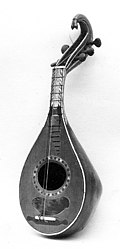
Back Mandora Catalan Mandora German Mandore (instrument) French マンドーラ Japanese Mandòra Occitan Mandora Polish Lutina Portuguese Мандора Russian
 Mandora c. 1700–1799 exhibited at the Metropolitan Museum of Art, NY | |
| String instrument | |
|---|---|
| Classification | |
| Related instruments | |
The mandore is a musical instrument, a small member of the lute family, teardrop shaped, with four to six courses of gut strings[2] and pitched in the treble range.[3] Considered a French instrument, with much of the surviving music coming from France, it was used across "Northern Europe" including Germany and Scotland. Although it went out of style, the French instrument has been revived for use in classical music. The instrument's most commonly played relatives today are members of the mandolin family and the bandurria.
The mandore arrived in France from Spain, and was considered a new instrument in French music books from the 1580s,[4] but can be seen as a development of the gittern.[5][6] In Spain the mandore was called vandola.[6][4] Musicologist James Tyler said that the Spanish bandurria with three strings was the mandore, although it had four strings when it arrived in France.[7] In its Spanish form the bandurria may have resembled the rebec.[7]
The mandore was played widely across Europe, just as the earlier gittern had been. The Italians called it the mandola and even as the instrument became obsolete elsewhere, by the mid 17th century they had developed it into "an instrument with its own distinct tuning, technique and music."[7] In Milan, Italy as the mandore or Lombardo, it remained in use into the late 19th century. That variant is known today as the Milanese or Lombardic mandolin, and retains the mandore's tuning. The Italians also called it the mandora or mandola. The latter name is still used in the mandolin family for an alto or tenor range instrument. From the mandola, the baroque mandolino was created, which in turn became the modern mandolin.[8][6][9]
The Germans continued to use quinterne, their name for the gittern. Michael Praetorius recorded the names mandürichen, bandürichen, mandoër, mandurinichen, mandörgen, and pandurina. The latter name, pandurina, was also applied in the 1700s in Italy to the Milanese mandolin.[10][11][12][3][8]
- ^ Dossena, Luigi (7 September 2014). "Historia et imago Cremae. La vita di Giovanni Vailati, il Paganini del mandolino: dai caffè cremaschi ai teatri d'Europa [translation: Historia et imago Cremae. The life of Giovanni Vailati, the Paganini of the mandolin: from the cremaschi cafés to the theaters of Europe]". cremonaonline.it. Retrieved 11 June 2018.
...on December 2, 1852 in Parma at the Regio theater he performed a single string music from his mandolin, on a Lombard-type mandolin inspired by sixteenth-century instruments still unformed and rough. It was a soprano lute, very small, having the semblance of a paunchy half-egg which he later replaced with a mandolin inspired by Hispanic Bandurria- type models...
- ^ McDonald 2008, pp. 7–8
- ^ a b Mandore [Mandorre]. ISBN 978-0-19-974339-1. Retrieved 2015-03-21.
{{cite book}}:|work=ignored (help) - ^ a b McDonald 2008, p. 7
- ^ Tyler 1981, pp. 22–31 "...the small, lute-like instrument of the Middle Ages called, until recently, the 'mandora' by modern writers, was originally called the 'gittern'...generally used for the small, four-course, renaissance guitar—but it was still also occasionally used (until well into the 17th century) for the instrument that, during the 16th century, became known as the 'mandore'."
- ^ a b c Randel, Don Michael (2003). The Harvard Dictionary of Music. Harvard University Press reference library. Vol. 16. Harvard University Press. p. 484. ISBN 978-0-674-01163-2.
Mandora, mandore, mandola [Fr. mandore; Ger. Mandoër, Mandürichen, Mandourlauten; It. Mandola; Sp. vandola]. (1) A lutelike instrument developed from the medieval *gittern. ... (2) An 18th-century Austrian and German eight course hybrid combining a lute body and pegbox with a guitar neck. This was played and tuned like the guitar: C D E A d g b e'. ...
- ^ a b c Tyler 1981, pp. 22–23 [1–2] "... it is to the Spaniard Juan Bermudo that we must turn... in his Declaration de instrumentos (1555), Bermudo speaks of the bandurria...the early bandurria, a small lute- or rebec-like instrument with 4th and 5th tunings, was the mandore...The Spanish sources seem to suggest that the early bandurria... was the mandore..."
- ^ a b Nikolova, Kőnemann (2000). The Illustrated Encyclopedia of Musical Instruments From all eras and regions of the world. Bulgaria: Kibea Publishing Company. p. 164. ISBN 3-8290-6079-3.
- ^ Whitney, William Dwight (1906). The Century Dictionary and Cyclopedia. New York: The Century Company. p. 3606.
mandola, mandora (man-do'la, -ra), n. [It.:see mandolin.] An older and larger variety of the mandolin. Compare pandura. Also mandore.
- ^ Tyler 1981, p. 23 [2].
- ^ Tyler, James (2001). "Mandore". In Sadie, Stanley; Tyrrell, John (eds.). The New Grove Dictionary of Music and Musicians (2nd ed.). London: Macmillan Publishers. ISBN 978-1-56159-239-5.
- ^ Lambert, Jeffrey C. François Chancy's Tablature de Mandore (PDF) (A Major Document). Retrieved 2013-06-23.

